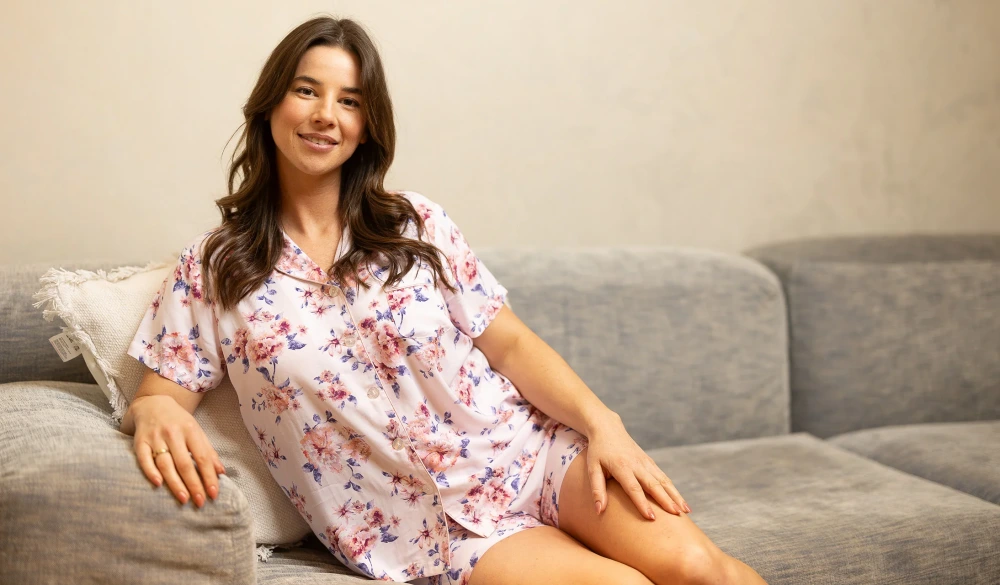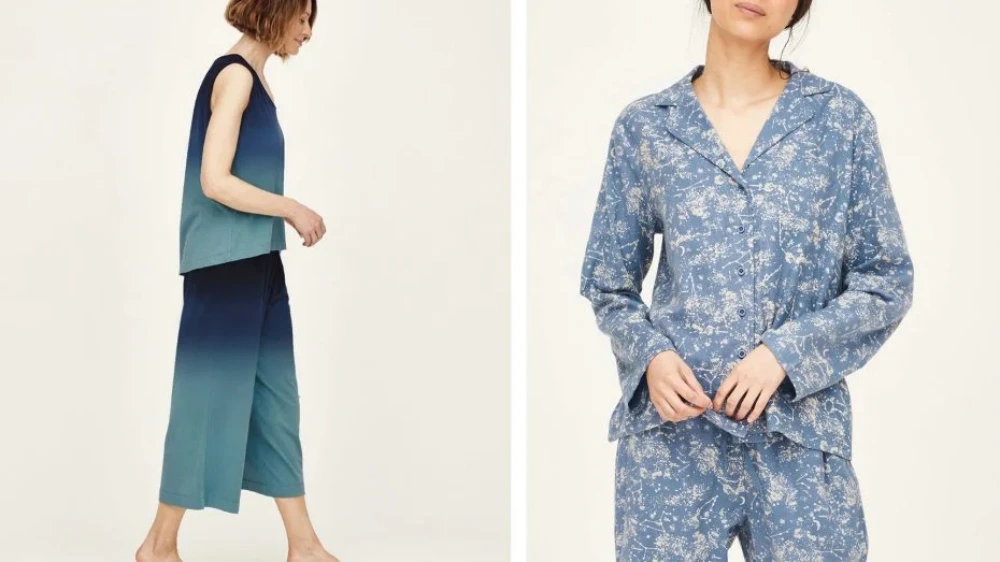Comparing Comfort, Care, and Sustainability
Explore key differences between Tencel and Viscose pajamas.
Features | ||
|---|---|---|
Softness | Silky, smooth, and luxurious feel | Soft and smooth but less silky |
Breathability | Excellent airflow, adapts to temperature | Great airflow, cool and lightweight |
Durability | Strong, keeps shape after washing | More delicate, weaker when wet |
Care Requirements | Easy wash, resists wrinkles and odors | Needs gentle care, prone to wrinkles |
Moisture-Wicking | Absorbs moisture quickly, dries fast | Good moisture absorption, slower drying |
Skin Sensitivity | Naturally hypoallergenic, gentle on skin | Generally gentle, may irritate some |
Sustainability | Eco-friendly, closed-loop production process | Less sustainable, varies by factory |
Price | Higher cost due to eco-friendly process | More affordable, simpler production |
Customization Options | Various blends and styles, eco-friendly dyes | Wide fabric blends, many prints available |
If you want the softest, most breathable, and eco-friendly pyjamas, you’ll notice tencel vs viscose stands out for different reasons. Tencel usually feels silkier and stays smooth wash after wash, while viscose gives you that cool, lightweight touch.
When you compare Tencel vs viscose for comfort, breathability, and sustainability, Tencel often wins thanks to its gentle feel and closed-loop eco process. Both fabrics make excellent sleepwear, and Friendtex offers stylish options in both for your sleepwear and underwear needs.
Key Takeaways
Tencel offers silky softness, strong durability, and easy care, making it ideal for long-lasting, comfortable pyjamas.
Viscose feels soft and cool but needs more delicate care and may wrinkle or wear out faster than Tencel.
Both fabrics breathe well and wick moisture, but Tencel better suits sensitive skin due to its hypoallergenic and gentle nature.
Tencel uses an eco-friendly closed-loop process that reduces waste and pollution, making it more sustainable than most viscose.
Choosing Tencel means investing in quality and sustainability, while viscose provides a budget-friendly option with a classic silky feel.
Tencel vs Viscose Overview
What is Tencel?
If you love soft, breathable pajamas, you’ve probably heard about Tencel. Tencel is a branded type of lyocell and modal fibers, made from natural fibers sourced from wood pulp—mainly eucalyptus. The process starts with wood from responsibly managed forests. Manufacturers dissolve the pulp in a non-toxic solvent, then spin it into fibers.
This closed-loop system recycles almost all the chemicals and uses much less water than traditional methods. The result? A fabric that feels silky, stays cool, and is gentle on your skin.
Friendtex uses Tencel in their pajamas, blending it with modal or bamboo for extra softness and stretch. You get pajamas that are not only comfy but also eco-friendly and durable.
What is Viscose?
Viscose is another popular fabric made from natural fibers. It comes from wood pulp, just like Tencel, but the process is a bit different. The pulp is treated with chemicals like sodium hydroxide and carbon disulfide, then spun into fibers.
This method has been around since the early 1900s and gives viscose its signature smooth, drapey feel.
Viscose pajamas from Friendtex offer a luxurious, silky touch and excellent breathability. They’re great for hot nights and feel gentle on your skin. However, viscose can be more delicate and needs a bit more care to keep it looking its best.
Are They the Same?
You might wonder if Tencel and viscose are just two names for the same thing. They both come from plant-based cellulose and fall under the category of regenerated natural fibers.
But here’s the key difference: Tencel (lyocell) uses a modern, closed-loop process that’s safer for the environment and produces stronger, more durable fibers.
Viscose relies on older chemical methods, which can be harsher on both the fabric and the planet. When you compare Tencel vs viscose, you’ll notice Tencel pajamas from Friendtex hold their shape better, resist shrinking, and feel softer wash after wash.
Viscose, while still soft and breathable, may not last as long or handle moisture as well. If you’re deciding between tencel vs viscose or even tencel vs cotton, think about what matters most to you—eco-friendliness, durability, or that classic silky feel.
Difference Between Tencel and Viscose
Fabric Properties
When you slip into a pair of Friendtex pyjamas, you want them to feel soft, smooth, and comfortable all night. Tencel, especially lyocell, stands out for its silky texture and gentle touch on your skin.
You’ll notice the softness right away, and it stays that way even after many washes. Viscose also feels soft and breathable, but it’s a bit more delicate and can wrinkle more easily.
Let’s break down the main fabric properties in a simple table:
Property | Friendtex Viscose Pyjamas | Friendtex Tencel (Lyocell) Pyjamas |
|---|---|---|
Softness | Very soft and lightweight | Soft, smooth, and luxurious |
Strength | Weaker when wet | Strong and durable, even when wet |
Wrinkle Resistance | Prone to wrinkling | Resists wrinkles, stays smooth |
You’ll love the way tencel holds its shape and resists wrinkles. If you want pyjamas that look fresh with less effort, Tencel is a great pick. Viscose feels amazing, but you might notice more creases after wearing or washing.
Tip: If you want the best of both worlds, Friendtex offers blends like Tencel Modal and Bamboo Tencel for extra softness and durability.
Durability
Durability matters when you want your favorite pyjamas to last. Tencel, especially lyocell, is known for its strong fibers. It keeps its shape and softness even after repeated washing.
You don’t have to worry about it losing strength when wet, which is a common issue with viscose. Viscose pyjamas feel soft, but they can become weaker and stretch out over time, especially if you wash them often.
Tencel also stands out for color retention. The fabric holds onto dyes, so your pyjamas stay vibrant and fresh-looking, even after many washes. Just remember to follow the care instructions—cold water, gentle cycle, and air drying—to keep the colors bright and the fabric strong.
Care
You want pyjamas that are easy to care for, right? Tencel makes your life simple. You can toss your Friendtex tencel pyjamas in the wash on a cold, gentle cycle. Turn them inside out, skip the bleach and fabric softeners, and let them air dry away from direct sunlight.
Tencel resists odors and wrinkles, so you don’t need to wash or iron them as often. If you do need to iron, use a warm iron with a pressing cloth or a steamer.
Viscose pyjamas need a bit more attention. They often require hand washing or even dry cleaning to keep them looking their best. Viscose is more likely to wrinkle, so you might spend more time ironing. If you want low-maintenance sleepwear, Tencel is the clear winner.
Friendtex Tencel Pyjamas:
Easy to wash and care for
Resist wrinkles and odors
Hold color and shape well
Friendtex Viscose Pyjamas:
Softer feel but higher maintenance
More prone to wrinkling and stretching
May need hand washing or dry cleaning
Choosing between Tencel and viscose comes down to what you value most. If you want lasting softness, easy care, and vibrant colors, tencel pyjamas from Friendtex are a smart choice. If you love that classic silky feel and don’t mind a little extra care, viscose can also be a lovely option.
Comfort in Pyjamas

When you shop for new sleepwear, comfort is probably your top priority. Let’s break down how Tencel and viscose stack up in terms of softness, breathability, and moisture-wicking, so you can pick the best pyjamas for your needs.
Softness
You want your pyjamas to feel soft against your skin, especially after a long day. Tencel stands out for its incredible softness. Many people describe it as silky, smooth, and almost luxurious.
Independent textile tests show that Tencel fabrics, especially those with fine yarns and twill weaves, feel softer than viscose. In fact, most people in wear trials say Tencel feels softer than cotton and even smoother than other fibers. If you have sensitive skin, you’ll likely notice the difference right away.
Friendtex Tencel pyjamas use these fine yarns and soft weaves, so you get that gentle, cloud-like touch every night. Viscose also feels soft and smooth, especially in bamboo viscose blends, but Tencel usually wins when it comes to pure softness. Both fabrics are gentle, but if you want the softest option, Tencel is the way to go.
Note: Many users with skin conditions like eczema report that Tencel feels softer and more comfortable than regular clothing.
Breathability
Breathability is key for a good night’s sleep, especially if you tend to get hot or cold at night. Tencel and viscose both offer excellent breathability, but there are some differences. Tencel is known for being a highly breathable fabric.
It allows air to flow easily, which helps regulate your body temperature. This means you stay cool in the summer and warm in the winter. Friendtex Tencel pyjamas are especially popular with people who want sleepwear that adapts to changing temperatures.
Viscose, especially bamboo viscose, is also praised for its breathability. It lets your skin breathe and feel light, making it a great choice for hot sleepers. Many reviews mention that bamboo viscose pyjamas keep you cool and comfortable, even on warm nights.
Here’s a quick comparison:
Feature | Friendtex Tencel Pyjamas | Friendtex Viscose Pyjamas |
|---|---|---|
Breathability | Excellent airflow, adapts to temperature | Great airflow, cool feel |
Best for | Hot and cold sleepers, sensitive skin | Hot sleepers, sensitive skin |
If you want pyjamas that help you sleep comfortably all year, both Tencel and viscose are strong choices. Tencel may have a slight edge for people who want a breathable fabric that also feels extra soft.
Moisture-Wicking
Nobody likes waking up sweaty or clammy. Moisture-wicking is the ability of a fabric to pull sweat away from your skin and help it evaporate. Tencel does a great job here. It absorbs moisture quickly and dries fast, so you stay dry and fresh. Many users say Tencel pyjamas help with night sweats and keep them comfortable through the night.
Viscose, especially bamboo viscose, also absorbs moisture well. It’s a favorite for people who want cool, dry sleepwear. However, lab tests show that while both Tencel and viscose absorb moisture, their ability to wick it away and dry quickly can depend on the fabric blend and weave.
Synthetic fabrics like polyester wick moisture faster, but Tencel and viscose still perform well for natural fibers.
Tip: If you struggle with night sweats or live in a humid climate, try Friendtex Tencel or bamboo viscose pyjamas for better comfort.
Which Is Best for You?
If you’re a hot sleeper, you’ll love the breathability and moisture-wicking of both Tencel and viscose.
Cold sleepers can also benefit from Tencel’s temperature-regulating properties. Sensitive skin? Tencel’s softness and hypoallergenic qualities make it a top pick. Friendtex offers both options, so you can choose what feels best for you.
Skin Sensitivity
Hypoallergenic Qualities
If you have sensitive skin, you know how important it is to choose the right fabric for your pyjamas. Tencel and viscose both come from plant-based fibers, but they offer different levels of protection for sensitive skin. Tencel stands out because it is naturally hypoallergenic.
Clinical studies show that Tencel fabrics help reduce skin irritation in people with eczema, even more than cotton. The smooth surface of Tencel fibers keeps dust mites and mildew away, which means fewer allergens touch your skin.
Certified Tencel products also avoid harmful chemicals and dyes, making them a safer choice for sensitive skin.
Viscose is also considered hypoallergenic for most people. Its smooth fiber structure does not have the scales that can cause allergic reactions, like wool does. Many people with sensitive skin find viscose comfortable and gentle.
However, some may react to leftover chemicals or dyes from the viscose production process. If you have very sensitive skin, you might want to look for viscose pyjamas that use organic or low-impact dyes.
Tip: Always check for certifications like OEKO-TEX or GOTS when shopping for pyjamas. These labels mean the fabric is free from harmful chemicals, which is better for sensitive skin.
Best for Sensitive Skin
When you compare Tencel and viscose for sensitive skin, Tencel usually comes out on top. Dermatologists often recommend Tencel for people with sensitive skin or skin conditions like eczema.
You get a fabric that feels soft, stays breathable, and wicks away moisture, which helps prevent irritation. Tencel’s smooth texture does not trigger itch receptors, so you feel more comfortable and experience less itching at night.
Clinical studies back this up. In one study, children with dermatitis wore Tencel sleepwear and scratched less, slept better, and had less redness. Adults with sensitive skin also reported that Tencel shirts felt softer and caused less itching than regular clothing.
Viscose is still a good option for sensitive skin, but Tencel’s moisture-wicking and hypoallergenic properties make it the better choice if you want the highest level of comfort and protection.
If you want pyjamas that truly care for your sensitive skin, Friendtex Tencel pyjamas are a smart pick. You get softness, breathability, and peace of mind every night.
Sustainable Fabric Choice

Environmental Impact
When you look for sustainable fabric, you want to know how each choice affects the planet. Tencel and viscose both come from wood pulp, but their environmental impact can be very different. Tencel uses a closed-loop process that recycles over 99% of its non-toxic solvent. This means less chemical waste and a much lower environmental impact compared to many other fabrics. You also avoid toxic chemicals, which helps protect water and soil.
Viscose can be sustainable, especially when produced in modern facilities in Europe. These factories use wood from responsibly managed forests and follow strict rules to reduce environmental impact. However, viscose made in some parts of Asia may have a higher environmental impact, sometimes close to synthetic fabrics like polyester. Life cycle assessments show that both Tencel and modern viscose have a lower environmental impact than cotton, which uses more water and land and causes more pollution.
Here’s a quick look at how these fabrics compare:
Tencel and modern viscose use less water and energy than cotton.
Tencel avoids toxic chemicals and recycles almost all solvents.
Viscose made in Europe is more sustainable than viscose made in Asia.
Both fabrics use wood pulp from certified, renewable sources.
Eco-Friendly Options
If you want eco-friendly sleepwear, you have great options with both Tencel and viscose. Friendtex leads the way by using certified, non-toxic Tencel fabric in a closed-loop process. This process keeps the environmental impact low and supports sustainability.
Friendtex also chooses additives and dyes that are safe for you and the planet. Their Tencel and viscose pyjamas carry certifications like OEKO-TEX and GOTS, so you know they meet high standards for safety and sustainability.
You can also look for other eco-labels like FSC, which shows the wood pulp comes from responsibly managed forests. TENCEL™ brand certification and PEFC also support sustainable fabric choices. Friendtex’s commitment to sustainable practices means you get pyjamas that are gentle on your skin and the environment.
If you care about sustainability, choosing Tencel or modern viscose from Friendtex is a smart move. You support eco-friendly production, renewable sourcing, and lower environmental impact—all while enjoying soft, comfortable pyjamas.
Cost and Value
Price Comparison
When you shop for new pyjamas, price often plays a big role in your decision. Tencel and viscose come with different price tags, and it helps to know why. Tencel pyjamas usually cost more than viscose.
The reason? Tencel uses a modern, closed-loop production system that’s better for the environment but also more expensive. This process recycles water and chemicals, making Tencel a premium, eco-friendly choice.
Viscose, on the other hand, uses a simpler and older chemical process. This makes viscose less costly to produce, so you’ll often find viscose pyjamas at a lower price point. Here’s a quick look at how the two compare:
Factor | Tencel (Lyocell) | Viscose (Rayon) |
|---|---|---|
Production Process | Advanced, eco-friendly | Simpler, chemical-based |
Relative Cost | Higher | Lower |
Durability | Excellent | Fair |
Care Requirements | Easier | More delicate |
Tip: If you want a budget-friendly option, viscose is a great pick. If you’re willing to invest a bit more for sustainability and long-lasting quality, Tencel is worth it.
Long-Term Value
You might wonder if paying more for Tencel is worth it. Let’s look at long-term value. Tencel stands out for its strength and durability. You can wash and wear Tencel pyjamas many times without losing softness or shape.
Viscose feels soft too, but it’s more delicate and may need replacing sooner, especially if you wash it often.
Check out this table to see how they stack up:
Fabric Type | Durability | Maintenance | Replacement Frequency |
|---|---|---|---|
Tencel | Strong, keeps shape | Easy care | Less frequent |
Viscose | More delicate | Needs gentle care | More frequent |
So, while Tencel costs more upfront, you save money in the long run because you won’t need to replace your pyjamas as often. If you want sleepwear that lasts and stays comfy, Tencel gives you great value over time. If you prefer to refresh your wardrobe more often or want a lower initial price, viscose is a solid choice.
Style and Options
Pyjama Styles

When you shop for pyjamas, you want choices that fit your lifestyle and taste. Friendtex gives you plenty of options in both Tencel and Viscose fabrics. You can pick from classic pajama sets, comfy loungewear, or even matching couples’ outfits.
If you need something special, you’ll find maternity pyjamas with stretchy, breathable fabrics like bamboo and cotton blends. These are perfect if you want extra comfort during pregnancy.
For colder months, you might love winter pyjamas with cozy cuffs and thermal fabrics. If you prefer something lighter, there are short sets and relaxed tops for summer.
Friendtex also offers tech-enhanced pyjamas with features like antibacterial finishes and temperature regulation. These styles help you stay fresh and comfortable all night.
You can find pyjamas for everyone—men, women, kids, and even babies. The size range covers petite to plus sizes, so you always get a great fit. Friendtex makes it easy to choose sleepwear that matches your needs, whether you want something simple or a bit more stylish.
Customization
You might want your pyjamas to feel unique or reflect your personality. Friendtex lets you customize both Tencel and Viscose pyjamas in many ways. You can choose from a wide selection of fabrics, including Bamboo Viscose and TENCEL™ Lyocell, both known for their silky, breathable feel.
Want to add a personal touch? Pick custom prints or embroidery—add your name, a logo, or even a fun pattern. Friendtex supports screen printing, digital printing, and sublimation, so your designs look vibrant and last wash after wash.
You can select from themed prints like animal patterns (cat, dog, leopard, cow) or go for seasonal designs. Holiday collections, such as Christmas pyjamas, make great gifts or family traditions.
Friendtex also offers private labeling, special packaging, and fast sampling if you want to create a custom collection. They use eco-friendly materials and water-based inks, so your custom pyjamas are as sustainable as they are stylish.
Tip: If you want something truly special, try a themed set for the holidays or a matching family collection. You’ll find options that suit every season and every style.
Conclusion
Choosing between Tencel and viscose for your pyjamas depends on what matters most to you. Here’s a quick side-by-side to help you decide:
Aspect | Tencel | Viscose |
|---|---|---|
Comfort | Silky, breathable, moisture-wicking | Soft, less breathable |
Skin Sensitivity | Hypoallergenic, gentle | May irritate some skin |
Sustainability | Eco-friendly, closed-loop | Less sustainable |
Cost | Higher | More affordable |
If you want the softest, most sustainable option, Tencel is your best bet. Prefer a lower price? Viscose works well, too. Friendtex offers both, so you can pick what feels right for you.
FAQ
Are Tencel and Viscose the same fabric?
No, they are not the same. Both come from wood pulp, but Tencel uses a modern, eco-friendly process. Viscose uses an older chemical method. You get different results in softness, durability, and sustainability.
Which fabric is better for hot sleepers?
You will probably prefer Tencel if you get hot at night. It breathes well and wicks away moisture. Viscose also feels cool, especially in bamboo blends, but Tencel usually keeps you drier and more comfortable.
Can I machine wash both Tencel and Viscose pyjamas?
You can machine wash Tencel pyjamas with ease. Use cold water and a gentle cycle. Viscose needs more care. Hand washing or dry cleaning works best to keep viscose looking great.
Which fabric is more eco-friendly?
Tencel stands out for sustainability. It’s a closed-loop process that recycles almost all water and solvents. Viscose can be eco-friendly if made in modern factories, but Tencel usually has a lower environmental impact.
Do both fabrics work for sensitive skin?
Yes, both feel gentle. Tencel is naturally hypoallergenic and often recommended for sensitive skin. Viscose feels soft, but some people may react to leftover chemicals. Always check for certifications if you have allergies.


